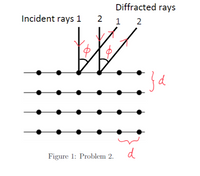Question
American physicists Davisson and Germer did a diffraction experiment in the
1920s to demonstrate the wave-like property of electrons. If d is 0.215 nm for a cubic
lattice crystal (see Fig. 1), and the incident beam is perpendicular to the surface of the
crystal,
(a) find the optical path length difference between ray 1 and ray 2 in terms of d
and φ.
(b) how much voltage has to be applied to a beam of electrons so the diffraction
peak would be observed at φ = 53.13°?

Transcribed Image Text:Diffracted rays
Incident rays 1
2
1
2
Figure 1: Problem 2.
Expert Solution
This question has been solved!
Explore an expertly crafted, step-by-step solution for a thorough understanding of key concepts.
Step by stepSolved in 2 steps with 2 images

Knowledge Booster
Similar questions
- (a) What is the energy in joules of an x-ray photon with wavelength 3.08 x 10-10 m? (b) Convert the energy to electron volts. kev (c) If more penetrating x-rays are desired, should the wavelength be increased or decreased? O increased decreased (d) Should the frequency be increased or decreased? increased O decreasedarrow_forward(a) A vacuum photocell is sequentially illuminated with light of different wavelengths 2. A voltmeter is used to determine that there is a different voltage between the cathode and the anode. V (iii) Determine a relation for Planck's constant in terms of pairs of voltage measurements at different wavelengths such that W₁ cancels out. (iv) Evaluate Planck's constant for the following pair of measurements: measurement 1 finds = 447 nm and V=635 mV, and measurement 2 finds = : 502 nm and V=339 mV.arrow_forwardIn designing an experiment, you want a beam of photons and a beam of electrons with thesame wavelength of 0.281 nm, equal to the separation of the Na and Cl ions in a crystal ofNaCl. Find the energy of the photons and the kinetic energy of the electrons in electrovolts(eV).arrow_forward
arrow_back_ios
arrow_forward_ios